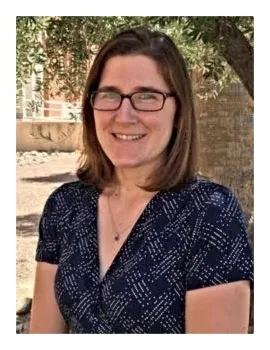HydroGEN Project Awarded $5M to Model National Water Resources Using Machine Learning
HydroGEN, a UArizona-led project leveraging CyVerse resources and funded by the National Science Foundation's Convergence Accelerator program, will allow researchers to build a national platform for hydrologic forecasting.

Willow Creek enters the Taylor Reservoir in Colorado. Photo by Drew Bennet.
As extreme weather events such as flooding and drought become more common in a climate impacted by humans, understanding and predicting water resources and systems becomes more important than ever.

Laura Condon
Laura Condon, a University of Arizona Assistant Professor of Hydrology and Atmospheric Sciences, and her team have received $5 million through a cooperative agreement from the National Science Foundation to use machine learning to build models of the Nation's watershed systems that can be used to forecast future conditions.
The project, dubbed HydroGEN (for Hydrologic Scenario Generation), will put the best hydrologic science directly in the hands of landscape managers, resource managers and policymakers so they can make informed decisions.
The knowledge gap between water management policy and the actual quantity and location of water in the ground, streams and rivers is not a problem of the distant future, said Co-Principal Investigator Reed Maxwell, Professor of Civil and Environmental Engineering at Princeton University, adding that it's happening right now. "Decision-makers are flying blind because they don't have the right tools to make the decisions they need to."
HydroGEN will provide new hydrologic data by combining abstract machine learning and modeling with real problems, according to Maxwell, who directs the Integrated GroundWater Modeling Center, based at Princeton's High Meadows Environmental Institute. The modeling center provides modeling and technology support for HydroGEN and HydroFrame, which is a national-scale hydrologic modeling platform Maxwell and Condon work on that forms the basis for HydroGEN.
Condon is principal investigator of the project, which is part of the National Science Foundation's Convergence Accelerator program, which aims to support interdisciplinary efforts to solve real-world problems quickly.
In September 2020, 29 teams from around the country were awarded Phase I funding to develop solutions in two areas – artificial intelligence-driven data sharing and modeling, and quantum technology. Over the last nine months, the teams engaged in an intense innovation curriculum to develop their ideas into prototypes. At the end of Phase I, teams participated in a formal Phase II proposal and pitch presentation. HydroGEN and one other University of Arizona research team project called Quantum Sensors, led by Materials Science and Engineering Assistant Professor Zheshen Zhang, were selected out of 10 projects to advance to Phase II. By the end of Phase II, teams are expected to develop impactful, sustainable solutions that address societal needs and continue to provide value beyond NSF support.
"A convergence approach paired with innovation concepts like human-centered design and solutions-focused research is important for solving large-scale national challenges," said Douglas Maughan, head of the NSF Convergence Accelerator program. "The NSF Convergence Accelerator is a young program, but we have already seen teams like HydroGEN apply our program fundamentals to move their solution forward. We are excited to welcome HydroGEN into Phase II and to guide the team and their solution to have a positive impact on our environment and the American public."
The team also includes Peter Melchior, an Assistant Professor of Astrophysical Sciences with a joint appointment in Princeton's Center for Statistics and Machine Learning.
"In today's complex and changing world, it is increasingly necessary for solutions to come from the convergence of disciplines and a diversity of thinkers coming together," said University of Arizona President Robert C. Robbins. "We need tools that can connect science directly to decision-makers and speed the pace of innovation. HydroGEN will be a platform that can help water managers make decisions using the best available science."
Advanced hydrological models capable of simulating rapidly changing ecosystems are often only used in an academic setting because they are time consuming and expensive to build and require extensive expertise. Many of the tools used by decision-makers rely on simplifications and assumptions based on past observed behaviors.
HydroGEN bridges that gap by using machine learning to allow any user to build models that are fast-running but scientifically rigorous.
"Our team has expertise in building really advanced hydrological models that cover everything from the bedrock to the treetops, over a national scale," Condon said. "We model hydrological systems that are changing and evolving really well, but these are hard to build and require huge computational resources."
Resource and landscape managers, policymakers and the public will be able to use these models to predict stream flow, soil moisture and groundwater on seasonal to annual time scales. This information is crucial for managing wildfires, pumping water for agriculture and other important water management decisions, Condon said.
Building a platform that can handle the model and the large data transfers needed for this approach is a significant challenge. So, Condon and her team have partnered with CyVerse, a UArizona-led NSF-funded organization dedicated to providing life scientists with computational infrastructure to handle and analyze large datasets.

Nirav Merchant
"Our University president always has in mind the Fourth Industrial Revolution, which is all fueled by machine learning and artificial intelligence," said Nirav Merchant, CyVerse Co-Principal Investigator and Director of the UArizona Data Science Institute. "Through CyVerse's cyberinfrastructure for collaborative data management and open science training opportunities, the University of Arizona is becoming a center for a lot of these initiatives, including the recently funded AI Institute for Resilient Agriculture. If you want to accelerate agriculture or space science, our researchers are at the forefront."
Merchant is also a HydroGEN project Co-Principal Investigator.
The team has also partnered with a Santa Barbara-based company, ViQi, which provides web-based visualization to make the 3D models and geospatial data interactive.
"Their work will make the information that the model provides easy to view, understand and interpret," Merchant said. "We don't want to dumb the experience down, but we do want to make it transparent. Our users will be making very important decisions, and they want to feel confident making them."
"We are excited to participate in such an important project given the circumstances, and we look forward to providing an easy-to-use and transparent experience for the users of the system who are required to make impactful decisions based on the information presented," said ViQi President Kris Kvilekval.
Over the next 24 months, the HydroGEN team will participate in the NSF Convergence Accelerator Phase II curriculum, focused on entrepreneurial concepts to include product development, intellectual property, financial resources, creating sustainable impact beyond NSF funding, as well as communications and outreach.

